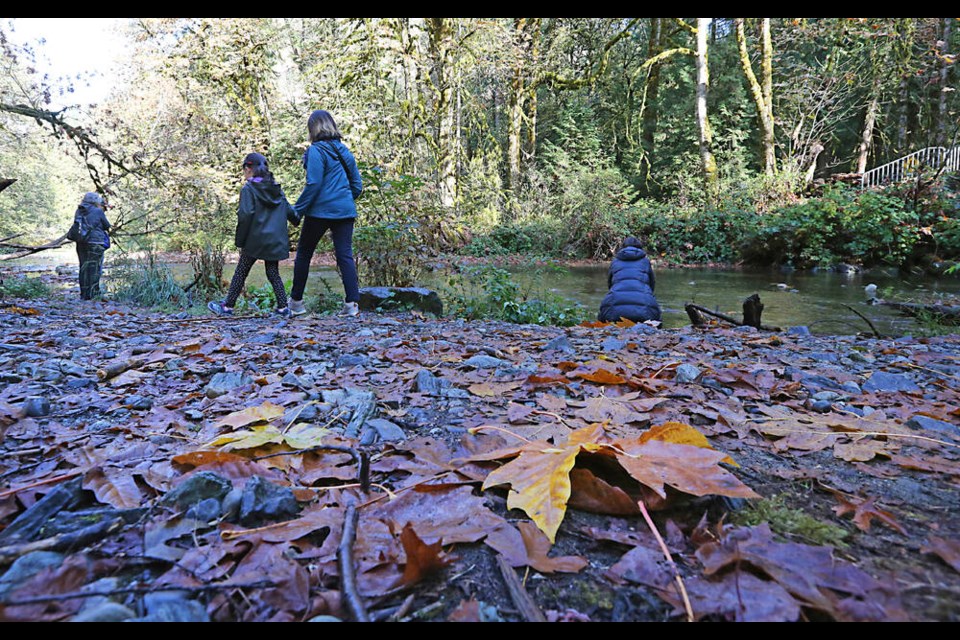Mother Nature is about to throw another wet and windy punch our way this weekend, with “continuous and significant rainfall” and strong winds forecast from Victoria to Port Hardy starting Saturday morning or afternoon, depending on where you live.
Rainfall, which is expected to last until Monday in some areas, will be heavier than the season’s initial atmospheric river on Thursday that knocked out power to more than 18,000 homes and caused dangerous driving conditions.
But it’s good news for salmon that are starting to mass in estuaries of Island rivers, eager to spawn.
Chum and coho salmon have been swimming in the Saanich Inlet, and a few are starting to enter the Goldstream River as water levels get a boost from recent rains — and a push from the Capital Regional District.
The CRD started releasing pulses of water into the Goldstream River this week at the request of the Goldstream Hatchery, opening dams on its Goldstream Lakes reservoir system — the river’s source — at a rate of about eight million gallons a day over a 10-day period.
With new rainfall, that should entice the salmon to enter the river and start spawning, Peter McCully, long-time technical adviser at the Goldstream Hatchery, said Friday. Lifting dams and weirs on sources has been essential on major river systems everywhere on the Island, as a record drought dried riverbeds before the start of the critical spawning period.
“The salmon are waiting and need the optimal conditions to come in,” said McCully. “Raising the river levels is a signal to them.”
McCully said some of the chum salmon have already been laying eggs in a mix of salt and fresh water in the estuary. Those eggs can survive in saline waters, but the coho eggs essential for brood stock for other area streams and rivers need fresh water.
“For chum, the need to spawn is immediate, and they are adapting in a certain level of salinity. The coho can wait, and they do require less water,” said McCully.
He said the typical peak spawn for Goldstream is still two weeks away, but he had been getting worried about water levels. “It looks promising now,” said McCully, though nobody can guess the rate of returns in any given year.
The Goldstream Lakes reservoir system, which consists of three bodies of water — Butchart Lake, Lubbe Lake and Goldstream Lake — is the CRD’s secondary water source and is not currently in use for taps or toilets.
Typically, about 4.5 million cubic metres, or about 45% of the available water supply in the Goldstream reservoirs, is released each year to keep water in the river, according to the CRD.
In a statement, the CRD said the Goldstream reservoirs are at 81% of storage capacity and rainfall into the winter is expected to replenish them.
Meanwhile, the regional district said the Sooke Reservoir, Greater Victoria’s primary supply of water, “flattened out” at about 69% of capacity this week, the end of a dry spell that lasted 105 days, with only a millimetre of rainfall over more than three months.
The reservoir is now slowly starting to rise, and rainfall over the weekend is expected to further raise the water level.
Heavy rainfall on the west coast of the Island this week prompted Fisheries and Oceans Canada to impose an emergency closure on harvesting shellfish in Barkley Sound on the west coast of the Island, citing possible contamination following intense rains after an extended period of drought.
As much as 82 millimetres of rain fell in a short period at Lennard Island Light Station on Thursday.
“As confirmed from bacteriological data collected during a water quality survey in Barkley Sound earlier this week, such conditions can degrade marine water quality due to excessive land wash,” Fisheries and Oceans Canada said.
Fisheries and Oceans Canada said conservation and protection fishery officers are stepping up patrols in the area so the public is aware of risks that include bacterial and viral contamination, including E. coli, norovirus and salmonella.
There is also a risk of paralytic shellfish poisoning in the area. Eating contaminated shellfish can cause severe illness and in some cases death, and cooking doesn’t destroy the toxins.



